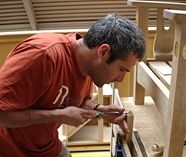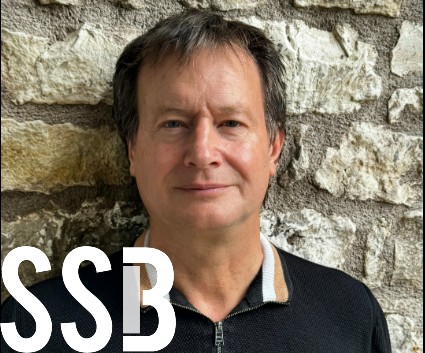Trevor Marchand on Craft
It’s an unusual approach for an academic: a hands-on approach. Literally a hands-on approach. Trevor Marchand is an anthropologist interested in how information about crafts is transferred from expert to novice. This has led him to Nigeria, Yemen, Mali, and East London and has required him to use his hands to build, among other things, minarets and homes of mud bricks.
Marchand, currently at SOAS, University of London, started his studies — in architecture — at Canada’s McGill University, which paved the way for field research on mud-brick building in northern Nigeria. That experience in turn spurred Marchand’s focus on an anthropological approach to architecture, a crafts-oriented approach to anthropology, and now study of how all of this plays out in a neuro-scientific context.
This unusual approach has also allowed him to build up a pile of awards resulting from his investigations. For example, his 2009 monograph on The Masons of Djenné, written after his rise from apprentice to skilled craftsman in this Malian city, won the Elliot P. Skinner Award from the Association for Africanist Anthropology, the 2010 Melville J. Herskovits Award from the African Studies Association, and the Amaury Talbot Prize for African Anthropology from the Royal Anthropological Institute. Just last year he was awarded the Rivers Memorial Medal by the Royal Anthropological Institute, an honor that recognizes exceptional work accomplished in the field.
In this Social Science Bites podcast, philosopher Nigel Warburton asks about Marchand’s field work, looking at what ties these disparate locales together and what sets them apart, not just in techniques but how craftspeople approach their work and how it influences them.
But as he tells Warburton, Marchand has a larger agenda behind his scholarship. “I think it’s extremely important for a general public to gain appreciation for the kind of skill and the diversity of knowledge that goes into producing something with the body,” he explains. “I think for far too long we’ve made that division between manual labour and intellectual work, and it’s something that goes back centuries. Leonardo da Vinci made that distinction between manual labour and intellectual work, and that distinction too between craft and fine art. And so, it’s been kind of relegated to the side-lines; it’s been marginalised and unfortunately vocational education – not just here in the UK but in other parts of the world – is something that children go into or are steered into when their peers or adults feel that they’re not academically inclined.”
To directly download this podcast, right click HERE and “Save Link As.”
Click HERE to download a PDF transcript of this conversation. The full text also appears below.
Social Science Bites is made in association with SAGE. For a complete listing of past Social Science Bites podcasts, click here.
***
David Edmonds: It’s an unusual approach for an academic: a hands-on approach. Literally a hands-on approach. Trevor Marchand is an anthropologist interested in how information about crafts is transferred from expert to novice. This has led him to Nigeria, Yemen, Mali, and East London and has required him to use his hands to build, among other things, minarets and homes of mudbrick.
Nigel Warburton: Trevor Marchand, welcome to Social Science Bites.
Trevor Marchand: Thank you for inviting me, Nigel and David. I’m looking forward to discussing with you.
NW: The topic we’re going to focus on is craft. Now, you’re a social anthropologist; what is the special interest in craft?
TM: Craft opens up a huge world. Craft is not simply the making of things but it’s the production and consumption of handmade objects. There’s also the politics of making things by hand; there is also the social relations that are involved between craftspeople: there’s a power hierarchy often between them, especially when you’re talking about training regimes where there’s a master and an apprentice, very interesting gender issues. So craft becomes a window onto an enormous social world.
NW: So as a researcher how do you narrow that down because that sounds almost as if you’re investigating the whole of the society when you look at the craft?
TM: I think I need to. I need to understand all of those aspects but the ones I’ve just named offer you a really… they’re kind of a part of a background that I work with. My real background is knowledge and learning. So, in order to understand how people learn something – how they acquire skills – I need to have an understanding of that full context because learning is contextual and it’s interactive. So I need to have an understanding of where they’re coming from and where they’re positioned in society and within their community of craftspeople to get a better grasp of how it is that they learn; everybody learns differently.
NW: So, can you give us one example of how you actually went about that?
TM: I enjoy working with my hands so choosing the kind of fieldwork method that I was going to be employing was actually quite straightforward for me. What I have always done classically in my fieldwork is I sign up as, usually start off as, a labourer. In Mali and in Yemen, I started off as a labourer and then I tried to work my way up to become an apprentice; I was taken on as an apprentice in Mali. So it’s a direct form of learning for me, so I engage with it by engaging myself every day in the subject material. And in the East End of London, working in the building crafts college, I signed on for the full two-year programme in fine woodworking. So, it was kind of a learning-by-doing.
NW: And learning by learning.
TM: And learning by learning, absolutely, and in fact that’s really what my ultimate goal is: it’s to learn about learning.
NW: Now, just to be clear, when you were working in Mali, for instance, you were actually working – you were researching – but at the same time you were earning a salary presumably or you were participating as a worker in this society?
TM: Yes. The salaries I’ve always foregone because I can never completely remove myself from my researching role. They knew I was there as a researcher, that was very clear from the beginning. I mean, ethically they had to know what I was there for and what I was looking for, but that was often forgotten in the day-to-day on the building site as I become a member of the team. And what was most important about me – most of the time – was the physical labour that I could contribute to a project as well as the social friendship and relations that I could provide. Also interestingly, I was a window, for a lot of workers that I was with, onto another world: I represented Canada, or Europe, or the West. And so, my interests in them was reciprocated by their interest in me and the world that I represented.
NW: So one of the things that you were working on was building minarets in Yemen. That’s an unusual thing for somebody from Canada to be doing. What was it like? What were you doing on a day-to-day basis?
TM: I did not expect to work on a minaretproject when I first came to Yemen. I was hoping that I would be able to team up with a group of house builders and perhaps work on the restoration of a house or kind-of a small project.
And it so happened that there was a minaret being built at the end of the road where I was first staying in Sana’a and it provided a wonderful opportunity to just go and sit on the curb – I literally sat on the curb each morning – and just watch them building. It was fascinating. There is no scaffolding used on these very high structures; they’re all built from the inside out. As the spiral staircase goes up, so do the exterior walls. So I would watch these masons perched on the top of the wall laying their bricks concentrically in circles and building higher and higher. And finally, one day, the master mason came down and he said ‘What are you doing?We see you every day.’ and I said ‘Well you know I’m hoping to work with some builders in the city, I’m trying to understand the building process as well as the apprentice system here.’ And he said ‘Why don’t you come up and see our work?’ So he invited me to the top of the minaret, he jumped off onto the top of the staircase, on to this narrow wall – at that point it was probably about 30 metres in the air – and he looked back at me and luckily I don’t have a fear of heights and so I jumped up onto the wall after him and followed him around the perimeter of the structure. I saidto him, ‘Boy! I would love to work with you on the minaret’ and he said ‘Aalaihi wasallam, you are welcome, and you can begin tomorrow.’
So I started the next morning and I worked with them for 13 months. But I kept my pen and notepad in my pocket; I wore big baggy work pants and they knew that sometimes I was stopping to take notes on things and I was working in the stairwell most of the time with the labourers – sometimes at the top as an apprentice with the masons. And I would stop and take notes; I did have a privileged position because the other labourers and even the apprentices on site were really not permitted to ask questions. It was considered to be an affront on the esteem/the status of the masters but they appreciated that my position was a little bit different and they tolerated my questioning from time to time. But most of what I was learning was simply through the social relations that I had with the other builders. But then we had more focussed discussions. In the afternoons when work would stop, people would get together to chew khat which was a mild narcotic leaf that’s chewed in South Arabia and parts of Africa. And that opened up time for reflection and for discussing ideas in greater depth, so I was learning from them in both capacities.
NW: I can imagine that process reveals a wealth of detail about the practicalities about building a minaret, but presumably you’re looking for generalities as well? It’s not just a matter of learning the specifics.
TM: And that goes back to something I was telling you before: I need to have that background information. For instance, working in Yemen, I needed to understand gender relations there. I needed to understand the role that crafts have played in the city; interestingly, they don’t have a guild-structure like they do in other parts of the Middle East. I had to understand the hierarchy on the building site, where their materials were coming from, and also the growing popular taste for traditional architecture. So all of that was very important and that’s the kind of stuff that I could learn from the literature and that’s normally where anthropologists get their background – it’s, you know, before you start, you brush up on the regional literature and you try to understand the site as well as you can before going in there. Because I’m interested in knowledge, learning, and embodiment, I have to go – I think – that extra step and become conversant or literate in the actions that I’m trying to understand. So I need to participate in them in the same way that I would brush up on the regional literature. So my participation gave me the background to draw upon to understand what they were doing and how they were learning in an embodied way more efficiently.
NW: What’s interesting to me is that you didn’t just stop with 13 months there but you immersed yourself in other craft situations at a similar level of depth. Presumably, things emerge that are patterns which are familiar and you can start to understand what’s going on more generally with people who are working with their hands?
TM: Yes, definitely. One of the reasons that I shifted sites to West Africa was I wanted to conduct a comparative study and there were some very interesting similarities; but I think perhaps even more interesting were the differences between the kinds of systems. In Yemen, the apprenticeship system is really quite strict and disciplinary, and the apprentice doesn’t have a fixed or stable role. If they fall out of favour, they are pushed back down the hierarchy and they’ll be made a labourer again, and somebody else in favour might be brought up.
In Djenné, where I worked, the position of an apprentice was more verbalised; it was usually a verbal contract made between the parents of the young man who was coming into the trade and the master mason who may or may not have been part of the family, the extended family. Their position was more stable, there was a lot more room for questioning and investigation on the parts of the labourers and the apprentices vis-à-vis the master masons. There was more humour and bantering on the building sites. I would say it was a more convivial place to work, in many ways. But perhaps most strikingly, both of them are Islamic contexts, but in Mali there was an integration of what you might gloss as non-Islamic beliefs: benedictions and spells played a very important role not just in people’s lives but in the building process itself. The masons would start off the morning by making benedictions before they would start laying bricks and that was for the safety of those working on site and also for the prosperity of those who would come to live there. And clients knew this, so it was actually important really for masons to almost perform these in a very overt fashion because people could see them; they could be witness to them and clients relied on that guarantee for their safety in the buildings and, arguably, benedictions were as important to a structure as the mortar between the bricks. So, that integration of different kinds of knowledge really made it a stark difference between my experience on the Yemeni building sites and those in Mali.
NW: And presumably that was quite different to your experience of woodworking in the East End of London.
TM: Absolutely. My next big case study was working with the fine woodworkers and the furniture makers and what I was looking to compare was the vocational training that somebody would undergo in a western, European context as opposed to what I had witnessed in West Africa or Arabia, and where the emphasis is much more on literacy and numeracy even though, at the end of the day, they are learning a set of embodied skills and learning about their materials and the specialised tools that they use, they are also expected to be numerate and literate. They are writing exams; they need to demonstrate that they can mathematically calculate the proportions of the piece of furniture that they’re working on. They work in measurements, and this was very different from the contexts in West Africa and Arabia where a lot of the young men that I worked with were not literate and they were not numerate and they were examined in a very different kind of way.
NW: So what you’re describing here is a range of different apprenticeships, a range of different approaches to learning in the craft situation. Are you attempting to view these from a neutral perspective, or through your engagement with these sub-cultures or cultures – whatever you like to call them – are you trying to give an angle which is political or moral on your research?
TM: My research has always had a political slant to it. I think of myself as a craftsperson – I’m originally an architect, and what I enjoyed most about architecture was the crafting of the drawings I produced, and I really enjoyed going to the building sites that I had designed and working on-site with the carpenter to try and figure out the geometries and how to solve problems which is another big emphasis in my research: problem solving in craftwork. I think it’s extremely important for a general public to gain appreciation for the kind of skill and the diversity of knowledge that goes into producing something with the body. I think for far too long we’ve made that division between manual labour and intellectual work, and it’s something that goes back centuries. Leonardo da Vinci made that distinction between manual labour and intellectual work, and that distinction too between craft and fine art. And so, it’s been kind of relegated to the side-lines; it’s been marginalised and unfortunately vocational education – not just here in the UK but in other parts of the world – is something that children go into or are steered into when their peers or adults feel that they’re not academically inclined. And so, part of my work is that exploration of the complexity of knowledge involved in making something and designing it.
I actually don’t think craft as an idea, or a concept, could exist without mass production and industrialisation. Its identity comes in the distinction it makes for itself as against industrialisation and mass production. In fact, I would say that there has been a really strong and steady interest in handicraft, and it’s not just for handmade things but it’s the politics that go along with it, and, increasingly so in the last few decades, there has also been the question of environment and sustainability.
NW: From your experience of a range of different apprenticeship situations, which is the best one?
TM: Well, I don’t think I’d impose any hierarchy on them. They’re all very different and I enjoyed working in all contexts immensely. But the vocational education that we’re perhaps offering young people here is weaker than other apprenticeships in some ways. The apprentices that I worked with in Arabia and Africa were not just learning the skills of putting up buildings; they were also learning on-site management. On a daily basis, they were exposed to the conversations between their masters and the suppliers of building materials, or negotiating budgets with the clients. They were also, on a daily basis very much involved in kind-of the moral comportment of what it is to be a craftsperson. The minaret builders that I worked with in Yemen, it was very important for the masons to be seen praying on a regular basis, to be observing Ramadan during that month. It was important for them to have that piety because their clients had more trust in them. Likewise, in Djenné, it was not just about putting up buildings, it’s about learning the benedictions; master will only pass those on to the apprentices that they’d established close relationships with and that they really trust, that they believe have really understood things. In the vocational college, there is a kind of a moral training as well. It certainly comes across through the conduct of the instructors; I have been privileged to work with people who are absolutely outstanding in terms of the kind of responsibility that they have taught their trainees towards clients and also working within budgets etc.
But, those everyday business interactions are missing from the college setting, obviously, and this is a really big problem because unlike a traditional apprentice working on site – they can move on; they’ve already got those business skills, those social skills, that way of comporting themselves that carries them logically on into running their own business. But, a lot of the students coming through the vocational colleges find it very difficult to set up on their own even though that is their ultimate aspiration.
NW: Surely it’s a feature of the modern world that the many things which were formerly done by hand are now done by machine. So, in a way, we’re moving away from the world of craft, aren’t we?
TM: The question that you ask is a very old one: Thomas Carlyle, and John Ruskin, and William Morris were very much interested in the same set of questions, along with a whole bunch of others ever since. I actually don’t think craft as an idea, or a concept, could exist without mass production and industrialisation. Its identity comes in the distinction it makes for itself as against industrialisation and mass production. In fact, I would say that there has been a really strong and steady interest in handicraft, and it’s not just for handmade things but it’s the politics that go along with it, and, increasingly so in the last few decades, there has also been the question of environment and sustainability. Clients are often interested in something with a story, and what better story can you have than you know something coming – you know where the materials are from, you know the craftsperson, and they can tell you story of how it’s made. One of the fundamental reasons that people can continue to go into handwork/craftwork is to regain, to re-establish that connection between themselves and their lives, with the materials they’re working with, the tools that they’re working with, that they’re gripping in their hands, and, hopefully, the market that they’re selling to, and perhaps even the territory on which they practice and sell. It really does go back to Marx’s concept of alienation or kinds of work that can perhaps bring you away from that sense of alienation.
I don’t think that this is merely a phenomenon in Western Europe. My understanding now of the context in Djenné for instance in Mali is quite similar in interesting ways. Djenné is a UNESCO World Heritage Site and it was made a site in 1988, which brings the entire urban fabric into almost a contestation. Who owns the heritage? Does it belong to the world – whatever abstract thing that is? Is it something for UNESCO to oversee? Does it any longer belong to the local population? And this has an impact on the position of the craftspeople who are continuing to build these buildings. It also puts limitations on them. In many respects, they are expected to reproduce the kind of traditional architecture that existed in the town when it was declared a UNESCO World Heritage Site. It limits their potential for innovation or for responding more directly to changing needs and tastes of clients. What they’re producing, in a certain sense, has become a commodity, and it’s no longer houses that people need but rather an architecture that has become a bourgeois commodity or value.
NW: Do you think that this research on learning and how we learn has changed your attitude to learning?
TM: Yes. One of the things I learnt first-hand on site – on the building sites – and even in the trade college is that you’re not always going to get the easy answers that you’re looking for from those who are your mentors and instructors, and some of the very best teachers I had were those who turned our question back into another question – a very Socratic kind of education. And what it produced was individuals who could think for themselves, and that’s something that I do try to implement with my students from undergraduate students to my PhD students. I want them to own their questions and their pursuits of knowledge. I want them to own their projects. I’m there as scaffolding, but at the end of the day their pleasure is going to come from them discovering answers, solutions, or just simply ways forward. So, that’s something that I’ve taken away from the building site.
NW: I can’t believe that working for so long with your hands hasn’t in some way led you away from academia because it’s a very different style of living from the typical academic.
TM: I think that I’ve always felt torn. I’ve always thought of myself as a maker and it’s probably still my greatest pleasure; it’s where I really lose myself, just being completely absorbed in designing something and making something. When I moved from architecture into anthropology, it was to address a set of theoretical questions that I knew would be better addressed in a PhD in anthropology rather than strictly architecture, and at that time I was still designing a little bit. So, I was doing my PhD and I was still designing my last houses, and since that time I’ve moved out of the profession – mostly – and I try to keep a balance between my academic work and still having hands-on involvement in making things around the house or for myself, but I very much look forward to a time where the balance is perhaps more in favour of the actual making again.
NW: Trevor Marchand, thank you very much.
TM: Thank you very much. I enjoyed that.


































































































To read:
Matthew Crawford, The Case for Working with Your Hands
Richard Sennett, The Craftsman